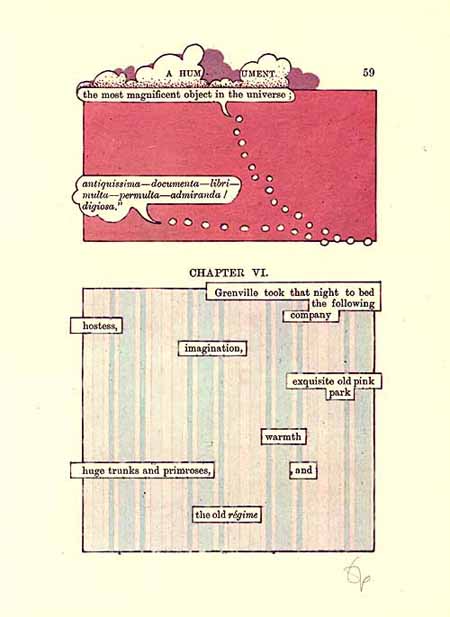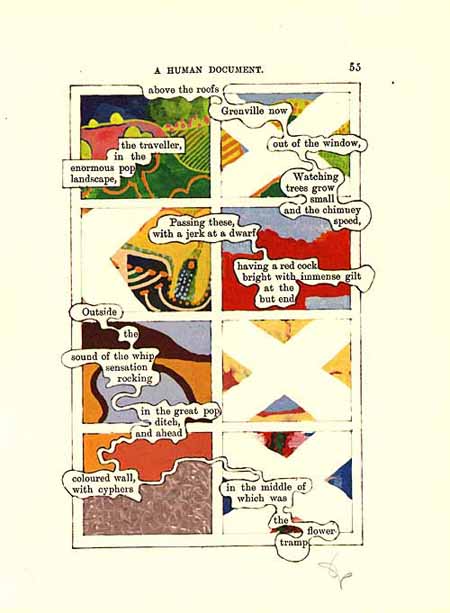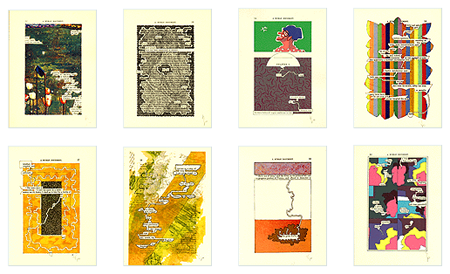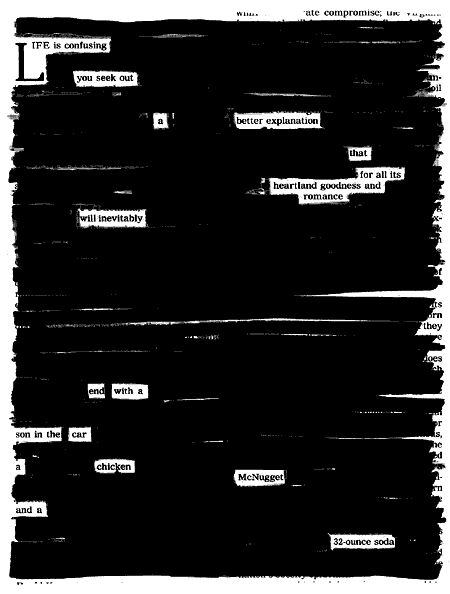Humument is Tom Phillips treated version of the Victorian novel ”A Human Document” by W.H. Mallock. Phillips transforms the text by drawing and painting over it and revealing just selected words. You can view the converted text online or in book form (Amazon).
In the mid-1960s, inspired by William Burroughs’s “cut-up” writing technique, Tom Phillips bought an obscure Victorian novel for three pence — W. H. Mallock’s 1892 novel, A Human Document. He began cutting and pasting the extant text, treating the pages with gouache and ink, isolating the words that interested him while scoring out unwanted words or painting over them. The result was A Humument, and the first version appeared in 1970.
The artist writes, “I plundered, mined, and undermined its text to make it yield the ghosts of other possible stories, scenes, poems, erotic incidents, and surrealist catastrophes which seemed to lurk within its wall of words. As I worked on it, I replaced the text I’d stripped away with visual images of all kinds. It began to tell and depict, among other memories, dreams, and reflections, the sad story of Bill Toge, one of love’s casualties.”





Karl N
on 09 Feb 07That’s my new favorite poem. Awesome.
Jeff Shell
on 09 Feb 07Crispin Glover employs similar techniques in his books which he also presents as slide shows. I got to witness one of these events at the height of my early fascination with Dada, Surrealism, Futurism, etc. Very fun.
f this
on 09 Feb 07what i mean to say is that if this same person had said he was “inspired by” the basecamp interface or “inspired by” zelman.com all hell would break loose… what a bunch of hyprocrites
Walker Hamilton
on 09 Feb 07You know, derivative works’ legalities are based on the percentage of the original work that is represented in the derivative, if the work is still covered by copyright…which in this case, it is not.
And, besides, this is a nice re-visualization of the work.
JeffC
on 09 Feb 07I love this work… named my college band after it (the original Human Document name not Humument).
Martin McClellan
on 10 Feb 07Incidentally, a Humument was also early to the web, with the first version of A Humument Homepage launching in 1996. I was lucky enough to work on it. Now it’s in the hands of the very talented John Nick Pull, who also keeps http://tomphillips.co.uk/. Phillips work is very deep and very broad. There’s a lot to discover there.
Dave Davis
on 11 Feb 07I’d nearly forgotten about this stuff, but the post very timely.
While reconsidering the practice of newsgathering for 21C media, I started looking at the way words fall on screens. This led to a form of prose that looked like poetry, and forced both economy and clarity at once. The farther I push this concept, the more I appreciate classic typography and caligraphy and even comics! Was the written word beggared and held hostage by machines in the industrial age? Whitman, e.e. cummings, Moholy-Nagy, each explored this terrain. Is it time to look closer, to consider the potential of type to speak more richly?
I’m not sure. But my early thoughts are posted online, with a PDF that goes farther, at: http://dataesthetic.org/dbdd/?p=44
d
Dave Davis
on 11 Feb 07oops… didn’t link that right! sorry…
Hopefully this one works!
d
This discussion is closed.